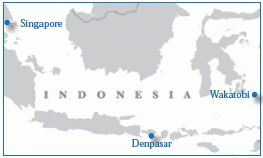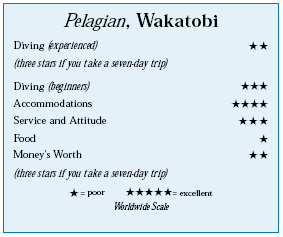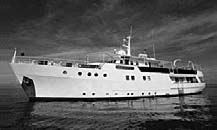The Pelagian, Wakatobi, IndonesiaContents of this Issue: Costa de Cocos, Xcalak, Mexico The Most Likely Time for Your Regulator to Fail The Pelagian, Wakatobi, Indonesia A Different Experience at Wakatobi Resort Is the Travel Info You Need Online? Got a Medical Emergency? Call DAN Again and Again Eliminating Underwater Terrorists Safety Concerns on Liveaboard Boats Yongala Victimís Husband Denies Murder, Sues Insurer Editorial Office: Ben Davison Publisher and Editor Undercurrent 3020 Bridgeway, Suite 102 Sausalito, CA 94965 mediocre food and few fish arenít worth the high price from the August, 2007 issue of Undercurrent
Dear Reader: Diving in Wakatobi offers two alternatives: a land-based operation with 52 guests staying in a holiday-camp atmosphere, or a trip aboard the Pelagian. While the Wakatobi Resortís ďhouse reefĒ is legendary for its diverse marine life and glorious wall, trips to nearby reefs involve a 45-minute ride with a dozen other divers. I opted for the Pelagianís quieter environs and access to sites the resortís motorboats canít reach. Wakatobiís service started with a flourish. After flying 13 hours to Tokyo, then eight more to Denpasar, Bali. I was met there by the staff, who sped me through customs and immigration. A twin-propeller beater delivered me three hours later to the remote airstrip on Tomia, a small island 400 miles east of Bali, and from there my boat trip took only 20 minutes. The Pelagian was the first stop. Five of us got off while the rest stayed onboard for the trip to Wakatobi on the island of Onemobaa. Unfortunately, the trip went steadily downhill. My 11-day trip was marked by repetitive dives at overfished sites, bad food and overpriced drinks. I canít complain about the comfortable accommodations or divemastersí optimistic cheer, but those werenít enough to make me feel I was getting $350-a-dayís worth of enjoyment. Wakatobi is an acronym for the larger islands -- Wangi, Kaledupa, Tomia, Binongki Ė in a group southeast of Sulawesi in the Banda Sea. The Pelagianís itinerary included an area 100 miles wide and 200 miles across, mostly in the Tukangbesi National Marine Park, but the area is so overfished, pelagic lovers will be disappointed. Wakatobi made a deal with locals to protect 12 miles of coastline from fishing, but this is tiny in comparison with the Pelagianís range. I came for muck diving, so my expectations werenít deflated, but the lack of reef fish gradually made diving less enjoyable.
Built in 1965 as a private yacht, the Pelagian was formerly the Fantasea, cruising the Red Sea before Wakatobi owners Lorenz Maeder and Erwin WŲber purchased and restored her. She is steady but slow, with a speed of seven knots. I had one of two deluxe cabins, with a double and twin bed. Every cabin had a large dresser and closets with room for suitcases. The air-conditioning was easily adjustable. Plush bathrobes and towels were luxurious touches. Roomy bathrooms had marble sinks and tile, glass-enclosed showers with rainshower heads giving plenty of pressure and hot water, and high-end toiletries. My end-of-day shower was a luxurious joy. The upper deck could double as a soccer field and offered comfortable seating under a canvas awning or in teak deck chairs. The area afore the cockpit was my favorite reading place -- always a cool breeze and I never encountered another guest there. The main deckís stern was spacious but the dining table was always covered in dripping camera gear. I wouldnít classify the Pelagian as photographer-friendly -- the camera room was too far from the dive deck. Neither of the two large rinse tanks was dedicated to cameras, so booties and masks shared muddy water with $10,000 camera setups. Despite complaints, the situation never improved. While the camera room could accommodate six photographers, I couldnít imagine the situation if all 12 guests required space. There are dozens of outlets, both 110 and 220 volts, for chargers but no air compressor. The four daily dives were at 7:30, 10:30, 2:30 and either a dusk dive at 5:30 or a 7:30 night dive after dinner. Aluminum 80s were filled to 3,000 psi. Dive times were limited to 70 minutes, 60 at night, so after paying a substantial premium for 32-percent Nitrox fills, I often came up from a 30-foot dive with a half a tank of air. For every dive, I climbed onto a peppy inflatable powered by two outboards. The two tenders handled six divers each, plus divemaster and pilot. I did rollouts and easily climbed back in on a long, angled ladder. Brom, my driver, who spoke fluent English, retrieved my BC before I boarded and treated camera gear as though it were his own. I used my safety sausages on two occasions, but otherwise the seas were calm and currents gentle. At the large plateau of Metropolis, I swam along the ridge and finally saw some large fish action -- gray reef and whitetip sharks, a large sea turtle and a huge school of blue fusiliers. Then we motored to Hoga in the Kaledupa Islands to explore the unusual contours of the Inner and Outer Pinnacles. I photographed a school of large chevron barracuda, lionfish, and porcelain crabs posed on mushroom anemones. Expansive fields of pristine table, brain and staghorn coral crowded together like commuters during rush hour. The dusk dive was through a series of pinnacles at Hoga Buoy, with large overhangs at 20 feet. Drifting through the stone reefs, I saw large crabs but little else. The Italian divemasters, Marco Camorali and Sissi Pagani, were very familiar
with dive sites and readily available for questions. The Pelagian strictly enforced
the buddy system so being a lone traveler, I was assigned as Marcoís buddy. Even though I went in June during dry season, it often rained so guests congregated in the salon, tight for 12 divers and two divemasters. Most DVDs were bootlegs and poor copies. Music always played from the boatís iPod but there was seldom agreement on selection or volume. There was a definite segregation between guests and crew. Was it mandated? The front of the boat was off limits to guests, and the crew never came midsection or aft, so I never learned about their country and customs. The salon doubled as the dining area. Standard breakfast choices were offered daily, and it was then when I chose my lunch and dinner from three choices. Servers happily accommodated requests and offered some interesting dishes, but overall the food wasnít well prepared. Meals were cold, and vegetables and meats were overcooked. One duck dish had the consistency of last weekís pot roast. Though dressed in imaginative sauces, the chicken was inedible. Desserts were rough. At least the salad ingredients were fresh and crisp, with plenty of ripe tomatoes, and delicious Indonesian fried rice and noodle dishes were good alternatives. A bottomless jar filled with delicious homemade cookies didnít last long, nor did the fruit bowl of mangosteens, salak and ripe bananas. Hot water and the espresso machine were always primed, although I grumbled about the drink prices. Local Bintang beer costing 50 cents at market was billed at $2.30. Sodas were $1.50. Mediocre wine retailing for $8 a bottle was sold here for $8.50 a glass and $40 to $60 a bottle. Some passengers racked up several hundred dollars in beverage bills. Between stops at reefs and walls, the captain motored at night toward the midway point of Butan Bay, a citadel of muck diving. I loaded my macro lens, champing at the bit to get in the mud. The first descent was to Asphalt Pier, a village dumping ground. Critters sheltered in truck tires, engine blocks, thousands of bras and other detritus of an expanding Third World civilization. I photographed Coleman shrimp, ribbon eels, longspine and mombasa lionfish, panda and saddleback anemone fish, and the elusive ghost pipefish, and enjoyed 45 minutes with a stunning juvenile batfish. The visibility was cramped at 50 feet, and the 78-degree water temperature was cooler than the average 84 degrees, but there was no current.
Next, I explored Chicky Beachís sandy slope down to 50 feet and was rewarded with harlequin shrimp, waspfish, gobies, blennies, puffers, and an acre of black spiny sea urchins offering protection for myriad juvenile reef fish I had only seen in field guides. Marco spotted the most expertly camouflaged critters, including a half-inch peacock razorfish tumbling in the gravel. Many photo ops were lost to a current-driven sandstorm but Neptune was forgiven after granting an incredible night dive. During 60 minutes at Magic Pier between two and 25 feet, I photographed mandarin fish and octopuses emerging from shadows, dense masses of shrimpfish and juvenile catfish, giant hermit crabs and a six-inch decorator crab resembling a ball of mohair yarn. Despite the interesting life here, there was no reason to dive the same four sites four days in a row. The weather had turned to pea soup and I suffered from cabin fever. Even if guests donít know where to go in an unfamiliar region, why not be given a choice of viable options? The Pelagian opted for the easy way out. The boat navigated back to Wangi Wangi Bay for two days of diving. Apart from pristine corals and sponges, nothing remarkable. I was resentful that I had traveled so far for such tepid diving. Iím the guy who never misses a dive, yet here I skipped several, as did half the other guests. At briefings, I asked, ďWill this be the same sort of wall dive?Ē Marcoís inpatient response: ďNo, different wall!Ē He and Sissi were tireless cheerleaders, but the fever was not contagious. Our night dive at Wangi Wangi was a waste of time. I was beckoned frantically to come see what Marco found. It was a crab. Ten minutes later I was summoned again, to see a lobster. I surfaced after 24 minutes without taking one photograph. At Blue Mosque, a double reef on Wangi Wangiís northern shore, I had an enjoyable ride at 35 feet past flawless coral gardens and gullies. A resident school of enormous bumphead parrots joined me for a bit, as did a puffer the size of a Labrador retriever. Fisherman worked the reef from dugouts, using crude hooks and handlines. Underwater, I saw freedivers spearfishing. They must be successful -- there are few large fish and no pelagics on these reefs. After a final, uneventful dive at Table Coral Rock, we were trapped on board for six hours while the Pelagian, which boasted a range of 8,000 miles, was using our time to refuel. A greasy wooden scow filled with gasoline rafted alongside us, its fumes filling the boat and ruining the only time I had to relax in the before a grueling trip home. It was more than an imposition, and dangerous. At night, we were ferried to Wakatobi for a barbecue. The food was passable, drinks were expensive at U.S. $9 apiece, and it was too crowded, although the divers there seemed happy enough. The Pelagian spreads a five-day itinerary across 10 days. If you go, consider the seven-day trip instead, and insist that your itinerary favor muck diving over walls and reefs. Itís too long a way to come for mediocre diving. -- D.L.
|

I want to get all the stories! Tell me how I can become an Undercurrent Online Member and get online access to all the articles of Undercurrent as well as thousands of first hand reports on dive operations world-wide
| Home | Online Members Area | My Account |
Login
|
Join
|
| Travel Index |
Dive Resort & Liveaboard Reviews
|
Featured Reports
|
Recent
Issues
|
Back Issues
|
|
Dive Gear
Index
|
Health/Safety Index
|
Environment & Misc.
Index
|
Seasonal Planner
|
Blogs
|
Free Articles
|
Book Picks
|
News
|
|
Special Offers
|
RSS
|
FAQ
|
About Us
|
Contact Us
|
Links
|
3020 Bridgeway, Ste 102, Sausalito, Ca 94965
All rights reserved.

 After an exhaustive, ill-timed briefing that
forced me to assemble equipment and cameras
in the dark, the boat motored south to start
the next dayís diving at Binongki. It was a
choice site for a checkout dive, but we spent
all day here. Standard dive profiles were
thrown to the wind. The first dive on Fish
Wall was in 30 feet of water for 70 minutes,
the second dive was a drift in 15 feet for an
hour. For the third dive, I descended to 135
feet and followed the Cavern Wall, covered in
pristine coral, barrel sponges, anemones and
nudibranchs. The reefs and walls were in mint
condition, reminding me of Palau and Red Sea reefs in the 1980s. For the night dive,
I was dropped onto Pintu Timur at Binongko. Not much to see, and we all agreed it
had just been one long checkout day.
After an exhaustive, ill-timed briefing that
forced me to assemble equipment and cameras
in the dark, the boat motored south to start
the next dayís diving at Binongki. It was a
choice site for a checkout dive, but we spent
all day here. Standard dive profiles were
thrown to the wind. The first dive on Fish
Wall was in 30 feet of water for 70 minutes,
the second dive was a drift in 15 feet for an
hour. For the third dive, I descended to 135
feet and followed the Cavern Wall, covered in
pristine coral, barrel sponges, anemones and
nudibranchs. The reefs and walls were in mint
condition, reminding me of Palau and Red Sea reefs in the 1980s. For the night dive,
I was dropped onto Pintu Timur at Binongko. Not much to see, and we all agreed it
had just been one long checkout day.  This didnít work well. I was kicked in the
head a dozen times, then admonished for
drifting ten yards behind him. But our
relationship greatly improved, and I
respected his profound interest in the
reef flora and fauna. After the third
day, the strict buddy rules were abandoned
and though dive times were still
limited, I was allowed to roam.
This didnít work well. I was kicked in the
head a dozen times, then admonished for
drifting ten yards behind him. But our
relationship greatly improved, and I
respected his profound interest in the
reef flora and fauna. After the third
day, the strict buddy rules were abandoned
and though dive times were still
limited, I was allowed to roam.
 Diverís Compass: For my 11-day trip, I spent $3,650 for a deluxe
cabin; itís $3,080 for a standard cabin and $4,050 for the master
suite . . . For the seven-night cruise, a standard cabin is $2,180
. . . I flew with American and Japan Airlines, connecting though
Tokyo then Denpasar . . . Thereís a recompression chamber in Denpasar
near the airport . . . Itís not considered a malaria hotspot but a
series of Malarone canít hurt; I experienced no side effects . . .
Since the Bali bombings, there are strict security procedures at airports
and hotels, but I felt no threats to my safety . . . Web site:
Diverís Compass: For my 11-day trip, I spent $3,650 for a deluxe
cabin; itís $3,080 for a standard cabin and $4,050 for the master
suite . . . For the seven-night cruise, a standard cabin is $2,180
. . . I flew with American and Japan Airlines, connecting though
Tokyo then Denpasar . . . Thereís a recompression chamber in Denpasar
near the airport . . . Itís not considered a malaria hotspot but a
series of Malarone canít hurt; I experienced no side effects . . .
Since the Bali bombings, there are strict security procedures at airports
and hotels, but I felt no threats to my safety . . . Web site:
